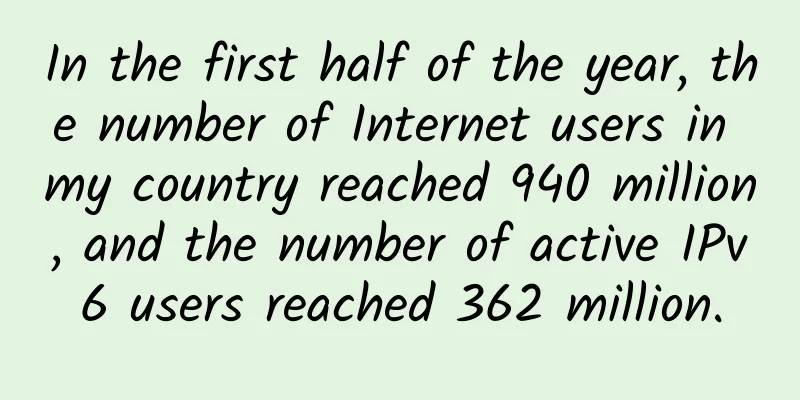Roaming on different networks is "running fast", can breakthroughs in standards open the door to a new world?

|
The Ministry of Industry and Information Technology recently announced the formulation of new industry standards. It is worth noting that two "5G inter-network roaming" standards - "Overall technical requirements for 5G inter-network roaming core network roaming" and "5G inter-network roaming core network roaming test methods" are listed. This means that cross-network roaming is still "running fast". But will the breakthrough in standards open the door to a new world of cross-network roaming? Roaming in different networks "Running fast with a mouth full of words"In fact, there is not much time left for roaming on other networks. In 2020, the Ministry of Industry and Information Technology issued relevant requirements of the "Implementation Opinions of the Ministry of Industry and Information Technology on Promoting Network Openness and Sharing and Promoting 5G Inter-Network Roaming" (MIIT Information Management [2020] No. 117). According to the plan, in 2021, we will promote the technical research and development of 5G cross-network roaming solutions, form relevant technical standards, formulate relevant testing standards, complete 5G cross-network roaming laboratory testing, and organize pilot work on existing networks. By the end of 2022, we will basically build a 5G network covering urban and rural areas, with advanced technology, excellent quality, intensive and efficient, safe and reliable, and fully promote 5G cross-network roaming. To support the full achievement of this goal, the Ministry of Industry and Information Technology issued the "14th Five-Year Plan for the Development of the Information and Communication Industry" in November 2021, and required the acceleration of 5G inter-network roaming testing and verification and equipment upgrades, so that all 5G networks in county-level and below administrative regions have inter-network roaming capabilities, encourage basic telecommunications companies to carry out inter-network roaming under market-oriented mechanisms, and support Tibet, Xinjiang, Inner Mongolia, Qinghai, Gansu, Heilongjiang and other provinces to give priority to inter-network roaming pilot projects. This breakthrough at the standards level lays a solid foundation for the full promotion of 5G cross-network roaming by the end of this year. The main drafting units of the two "5G inter-network roaming" standards mentioned above are China Academy of Information and Communications Technology, China Telecom Group Co., Ltd., China Mobile Communications Group Co., Ltd., and China Unicom Group Co., Ltd. The three major operators will jointly formulate relevant industry technical standards and negotiate on important issues such as the technical solutions for 5G inter-network roaming and the settlement prices for inter-network roaming. "Traveling fast with the message in hand", the future of roaming on different networks seems to be clearly visible. Roaming on different networks is more “intensive and efficient”What exactly is inter-network roaming? Why has the Ministry of Industry and Information Technology been vigorously promoting inter-network roaming? According to Baidu Encyclopedia, cross-network roaming means that a SIM card signed with a specific telecommunications operator can also use the network of another telecommunications operator. For example, the international roaming that everyone is familiar with is a type of cross-network roaming, where users can use mobile communication services by accessing the network of overseas operators. Therefore, many users have used cross-network roaming services. From the perspective of roaming scenarios, there are mainly two types. One is that the home network has no wireless signal in the roaming area, the visited network has 4G/5G signal, and the roaming user only uses the 5G network of the visited network. The other is that the home network has 4G signal but no 5G signal in the roaming area, the visited network has 4G/5G signal, and the roaming user gives priority to the visited 5G network. Combined with the actual situation in China, the second roaming scenario is more in line with the actual needs of 5G co-construction and sharing in China. The reason is simple: the 4G network coverage capabilities of the three domestic operators are almost the same; but the potential coverage capabilities of 5G are very different. The original intention of promoting cross-network roaming is also very obvious, because it is more "intensive and efficient". The Ministry of Industry and Information Technology once pointed out that it is necessary to accelerate the formation of a network structure in which multiple networks coexist in hot spots and one network is used as the bottom line in remote areas, and to build a 5G network that is resource-intensive and efficient in operation. The existing 5G network is generally based on medium and high frequency bands, lacking low frequencies below 1GHz. The lack of low frequencies means the lack of low-cost coverage capabilities; and if 5G wants to truly improve network utilization and increase the diversion ratio, it must enhance coverage capabilities. However, spectrum resources are precious and scarce. It is difficult for China Telecom and China Unicom to obtain sufficient spectrum resources and build networks in the short term (China Telecom's 800M and China Unicom's 900M are 4G base networks, and there is no timetable for spectrum recultivation), so they want to use the 700M 5G network of China Mobile-Radio and Television in a different network roaming way. In addition, 5G inter-network roaming can maximize the promotion of network openness and sharing, strengthen resource reuse, and improve the overall development efficiency of 5G networks. 5G inter-network roaming includes two technical routes: core network roaming and access network sharing. In the roaming area, roaming operators provide voice, data, short message and other services to users of their own network and roaming users of other operators, ensuring the same communication quality. How does cross-network roaming open the door to a new world?The future of cross-network roaming is bright, but the road ahead is full of thorns. Experts from China Unicom Research Institute once wrote that the implementation of 5G cross-network roaming still faces the following challenges: First, there are no international precedents and international standards for reference. Equipment and terminal capabilities are immature, including SEPP equipment that is crucial for roaming in different networks. There are no products available for testing. NSSF equipment does not support special slice mapping, etc. It is recommended to accelerate the advancement of technical research, standard formulation, and testing and verification, and promote the development of equipment and the formation of the industrial chain. Second, the imbalance problem in the domestic telecommunications industry still exists. Under the conditions of unequal market share and network coverage, it is foreseeable that the possibility of domestic basic operators reaching a consensus on the technical solutions and settlement prices of 5G roaming on different networks is very small. It is recommended that the regulatory authorities take the lead in determining the technical route and interconnection plan, and formulate a unified settlement price for slow roaming on different networks. Today, these problems and difficulties are gradually being resolved. Previously, the three major operators had different attitudes towards roaming: China Telecom and China Unicom have been actively promoting 5G roaming, while China Mobile (China Broadcasting Corporation) has a more ambiguous attitude towards it. Now the three operators have come together to formulate 5G roaming standards, which is a big breakthrough. Of course, this action has also won praise from many netizens on the Communication People's Home! Another Communication People's Home netizen pointed out that cross-network roaming has a reverse incentive effect on operators. "We should not be proud of roaming, but ashamed of it. Only with this idea can we promote the overall improvement of coverage for both parties!" After all, for operators, high-quality differentiated development and good customer service are the key. However, some netizens also expressed some concerns: "Inter-network roaming is beneficial to China Telecom in the short term, but detrimental to China Telecom in the long term. Due to the market mechanism, China Telecom users need to settle charges between networks when roaming to a mobile network. The roaming fee should be higher than the network fee. After experiencing it, users will gradually apply for number portability and become permanent users of China Mobile. Due to its ability to bear benefits, China Telecom's network coverage in rural areas will further shrink, creating a vicious cycle and becoming a large virtual operator." In fact, this is also the key to whether 5G roaming can be truly implemented. Formulating a unified roaming settlement price is also the most challenging part of the regulatory decision-making wisdom. Only by doing this can roaming truly open the door to a new world! |
<<: How to display IP location across the entire network?
>>: Gartner: China's IT spending is expected to exceed US$550 million in 2022
Recommend
5G commercialization has arrived, and the chip market has ushered in new development opportunities
The future of the Internet of Everything, which s...
Ruishu Information is listed as a representative manufacturer in the field of online anti-fraud in Gartner's "Online Anti-Fraud Market Guide" report!
In July 2021, Gartner, a global authoritative IT ...
This scale is unparalleled. 2017 Huawei All Connect Conference wonderful online reviews
The 2017 Huawei Connect Conference officially cam...
In-depth analysis of the seven major communication protocols of IOT
In the Internet of Things protocol, it is general...
5G+IoT, why will it usher in a completely different era of “operator of everything”?
In the previous article "Entering the Billio...
On "GPL is a trap for software developers"
[[381740]] This article is reprinted from the WeC...
Thirty years of changes and evolution of Internet core protocols
When the Internet began to be widely used in the ...
How SD-WAN is changing the network services market
As technology continues to evolve, SD-WAN (wide-a...
5G package users exceed 200 million, 5G mobile phones are accelerating into the popularization period
Recently, China Mobile, China Telecom and China U...
CVPR2025 | MobileMamba: A new breakthrough in lightweight Mamba network, taking into account multiple receptive fields, efficient reasoning and super precision
1. Overview at a glance MobileMamba proposes a li...
What kind of sparks will be created when 5G meets the power grid?
In the past, electricity changed the way of produ...
DAGW: Exploration and Practice of Data Aggregation Gateway
Business Background Bilibili is a video community...
From R15 to R17, understand 5G's technological innovation in one article
In early June 2022, the 96th plenary session of t...
When the "cold current" of the epidemic meets the "warm current" of 5G, can terminal manufacturers turn crisis into opportunity?
Amid the pandemic, terminal manufacturers have st...
Optimization practice of real-time 1V1 Q&A RUDP transmission with global 250 milliseconds delay
Recently, I have talked with many friends in the ...









